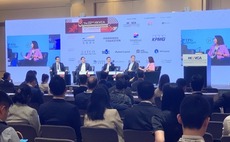
Secondaries: Stick or twist?

After several years of rapid growth, secondaries volumes slowed in the first half of 2016, while fundraising reached an all-time high. Opinion is divided on the prospects for an increasingly nuanced market
For the global secondaries market, Goldman Sachs is the $6 billion gorilla in the room; that is the estimated total in PE assets the bank has to divest over the next 12 months in order to comply with US regulations. It is not alone in facing this deadline. Of the other big beasts, HSBC is said to have $3-4 billion on its balance sheet, while dozens of smaller players are also expected to launch sale processes.
The Volcker Rule, which imposes limits banks' exposure to alternative assets, has long been hanging over the financial services industry. It has already delivered a number of secondary sales, but uncertainty over the timing and terms of implementation prompted some groups to delay. Now, though, they face a July 2017 compliance deadline, so deals are expected to flow. It remains to be seen how fast.
"Doors are worn down with all the knocking from secondary buyers and intermediaries, so they are probably well aware who they want to call when the time comes. It will likely be an efficient process when they come into the market," says Jason Sambanju, head of Asia private equity secondaries at Deutsche Bank.
Financial institutions are no longer the lifeblood of the secondaries market, but any big ticket transactions will be welcome, particularly given that the slowdown in first half volume coincided with a new record high for fundraising. Depending on whom you ask, after several years of rapid growth, the industry is either in the midst of a temporary setback or at a potentially dangerous moment of reckoning thanks to unsustainable amounts of capital and consequent price inflation.
Behind the numbers
First, the fundraising. Over the past 18 months three of the five largest secondaries funds ever raised have achieved final closes, according to Preqin. As of early September, $17 billion had been committed to secondaries vehicles in 2016, compared to full-year totals of $27 billion and $20 billion in 2014 and 2015. Close to 40 managers are currently in the market, seeking an aggregate $24 billion.
Meanwhile, Greenhill Cogent recorded $12 billion in completed secondary transactions in the first half of the year, the lowest since 2013. The full-year 2014 and 2015 marks of $42 billion and $40 billion are unlikely to be eclipsed. Setter Capital reports a similar phenomenon: PE secondaries fell 7.3% year-on-year to $15.3 billion; the 12-month totals for 2015 and 2014 were $49.6 billion and $49.3 billion, respectively.
"We are seeing a slowdown this year compared to last year, in terms of both the total supply of deal flow and completed transactions," says Adam Howarth, co-head of private equity secondaries at Partners Group. "If you look at the calendar year, there were was some volatility in the first quarter - equity and credit markets were a little uncertain - and then there were concerns about Brexit. These have all played a part in making people unsure where year-end valuations are going to come out."
He is not alone in citing macroeconomic volatility as the key contributor to the slowdown. The net impact was a widening of the bid-ask spread as sellers held firm on pricing while buyers sought greater discounts to reflect the higher level of risk they are taking by pursing transactions in the current environment.
Andy Nick, a managing director at Greenhill Cogent, describes the deadlock as "a temporary pause on the buy side." He claims to have seen an uptick in activity in the second quarter as the public equities rebounded and expects the market to retain its momentum, resulting in a busy second half. "Based on our pipeline, it's going to be a busy September and October. Not all of those will ultimately come to market in the near-term, but then other sellers always pop up that weren't on the radar as people try to get deals done by year-end," Nick says.
Much ground would be made up if just a handful of large portfolio transactions comprising hundreds of fund assets reached completion. According to Setter, the 10 largest buyers - defined as those that deployed more than $600 million in the first half - accounted for 57.1% of total volume across private equity, real estate, hedge funds, infrastructure and timberland. There were only two $1 billion-plus transactions during the first six months, compared to three in the first half of 2015; factor in a couple of sizeable deals before year-end and the industry-wide total would spike.
Greenhill Cogent put the average high bid across all strategies at 87% of net asset value (NAV) in the first half, down slightly from 90% in 2015 as a whole. It claims that ample dry powder targeting secondaries is responsible for these seller-favorable dynamics. The recent slowdown in activity has allowed even more latent firepower to build up as funds fall below their target deployment pace for the year. Dry powder amounted to $65 billion as of the end of July, up from $58 billion at the end of 2015.
Where's the bubble?
As to where most of this capital is looking to be deployed, the consensus view is "plain vanilla" LP secondaries. "This is the largest segment of the market, and if you think about who is bidding, it's the easiest part of the market to start playing in as opposed to fund restructurings and other more complex areas," says Doug Coulter, a partner at LGT Capital Partners. "So that is where there is most competition and you see the highest prices. That part of the market is difficult right now, although it could change in six months."
More specifically, heavily contested assets tend to be relatively easy to understand and underwrite, and they come through intermediated processes. Greenhill Cogent's Nick sees strong competition for anything in the $50 million to $1 billion range.
"Things are very much influenced by what is happening at the top end of the market, which is more leverage-driven, and you've seen prices go up and projected returns come down," adds Deutsche Bank's Sambanju. "These large funds constitute a large portion of the dry powder, so how they behave, how they price assets, has a disproportionally larger impact on the overall market. In the middle market, where we have been operating, we don't see this as much."
The counterargument made by firms sitting near the pinnacle of the top end is that they belong in a category of their own. While there are few very large transactions available, even fewer managers - typically Ardian, Coller Capital and Lexington Partners - are able to write checks of $1 billion or more, and call upon LP co-investors to help soak up the equity.
Intel Capital's proposed secondary deal, which was withdrawn earlier this year, is a case in point. According to sources familiar with the situation, the GP wanted to work with a buyer that could underwrite the entire $1 billion transaction, but not even the largest managers would want that much exposure to a direct portfolio of venture and growth assets. An executive with a large cap secondaries player notes that his firm is well positioned to engage in bilateral discussions with sellers that certainty of closing because it can bring together the capital required.
Conversely, a mid-market GP observes that a $150-200 million deal would already be large for portfolio concentration reasons; it could stretch to as much as $500 million with contributions from LPs, by which point it would already be minority participant in the transaction.
While leverage, deferred payments and club deals with other managers have enabled some smaller buyers to scale up, the real X factor in secondaries is capital committed by LPs directly, either alongside portfolio GPs or independently. For example, Setter's headline multi-class transaction volume figure for the first half of 2016 is based on the activities of 119 established secondary buyers; more than 1,000 opportunistic and non-traditional buyers are not included.
This category covers LPs that pick up single positions in funds operated by managers they know and like as well as the handful of sovereign wealth funds and large pension plans that increasingly have their own secondaries teams and compete for portfolio deals.
"For those with teams devoted to secondaries, you can generally get a sense of the highs and lows they would invest in any given year. For people who don't have dedicated teams and might co-invest with secondary managers, it's very hard to calculate the dry powder," says Nick of Greenhill Cogent. However, he does note that capital from the likes of sovereign wealth funds, endowments and foundations tends to go up when pricing comes down, confirming the sense that activity is driven more by opportunism than portfolio management.
Even if the imbalance between capital raised and capital being put to work represents a temporary blip, the capacity of non-traditional investors - it is suggested in some quarters that there could be more than $100 billion of potential money chasing deals - contributes to concerns about competition and pricing in certain segments of the market. And while the pullback in the first half could be seen as evidence of discipline during a period of volatility and heady prices, there is still pressure to deploy.
"If you are a very large fund and drawing fees on a yearly basis, you have to do deals and put money to work or it hurts your net IRR and carry," says one industry participant. "As a result, deals get paid up, maybe the quality of underwriting goes down, and things go through that ordinarily would not. No one really knows, it is too early to say, but there is a healthy skepticism about the quality of returns that will come out of these vintages."
Long-term game
There are, of course, caveats - some that will be felt in the long term, if not the next couple of vintages. First, it is unclear how significant a role the likes of sovereign wealth funds will come to play in the market on an independent basis; they may find that paying a fee to a manager for deal sourcing, execution and management represents a more efficient use of resources, particularly if there is co-investment on top.
Second, if returns suffer due to excess capital then the market will correct, but this may have little impact on the broader trajectory of the secondaries market. Deutsche Bank's Sambanju observes that only 1-2% of PE assets under management globally currently enter the hands of secondary buyers, a fraction of the volumes seen in listed equities. A steady increase in deal flow over multiple years therefore seems logical.
Both Greenhill Cogent and Setter have recorded a growing sophistication in the way LPs use secondaries and this is also apparent on the GP side, with GP-led transactions accounting for an increasing portion of overall activity. While much of this is driven by end-of-life solutions for funds raised before the global financial crisis by managers that are now in difficulty, a number of established players are now accessing the market on a more strategic basis to clean up older funds. Howarth of Partners Group adds that this proactive engagement can also take place earlier in a fund's life.
Another consideration is that secondaries is not the only asset class, within and outside of private equity, where returns are coming under pressure. "Deals are being underwritten to lower returns across the board, but in a zero interest rate environment, are you still getting potentially attractive returns given the risk you are taking? The answer is yes," says LGT's Coulter, although he warns that using high levels of leverage on transactions brings an additional layer of risk.
Mid-cap players in the secondary market emphasize the competitive advantage that comes with sourcing deals on a proprietary basis through their preexisting relationships with GPs.
However, in the current economic climate the onus is on all industry participants to make the most of their competitive advantages - whether targeting smaller transactions that fall below the radar or leveraging a lower cost of capital at the large end of the market. The general appreciation in net asset value that has boosted many secondaries investments in recent years may not be available going forward.
"You need to be flexible and scale up if it's the right situation or scale down and pick off pieces that are attractive to you. You want to go where you have insights into the assets, where you have conviction that you are not taking on more risk to generate the returns investors are expecting," says Howarth of Partners Group. "If we have an informational advantage, I don't mind being the winner in a process. What would concern me is if we won every process that we looked at."
Latest News
Asian GPs slow implementation of ESG policies - survey
Asia-based private equity firms are assigning more dedicated resources to environment, social, and governance (ESG) programmes, but policy changes have slowed in the past 12 months, in part due to concerns raised internally and by LPs, according to a...
Singapore fintech start-up LXA gets $10m seed round
New Enterprise Associates (NEA) has led a USD 10m seed round for Singapore’s LXA, a financial technology start-up launched by a former Asia senior executive at The Blackstone Group.
India's InCred announces $60m round, claims unicorn status
Indian non-bank lender InCred Financial Services said it has received INR 5bn (USD 60m) at a valuation of at least USD 1bn from unnamed investors including “a global private equity fund.”
Insight leads $50m round for Australia's Roller
Insight Partners has led a USD 50m round for Australia’s Roller, a venue management software provider specializing in family fun parks.







